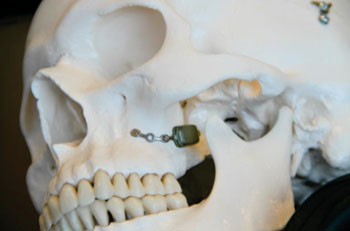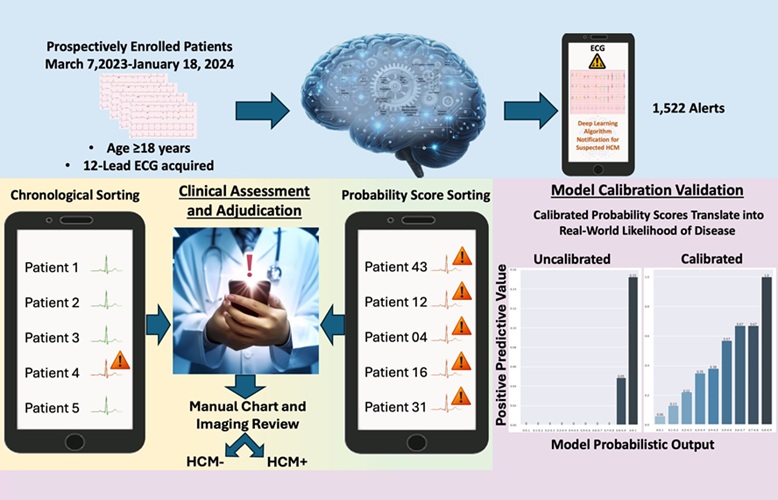Implanted Neurostimulation Device Treats Cluster Headaches 
|
By HospiMedica International staff writers Posted on 31 Aug 2014 |

Image: The ATI Neurostimulation System (Photo courtesy of Autonomic Technologies).
A miniaturized, multichannel, peripheral nerve stimulator, smaller than an almond, could provide relief from cluster headaches, which are more painful than migraines.
The ATI Neurostimulation System is an implantable rechargeable neurostimulator that delivers low level energy to stimulate the sphenopalatine ganglion (SPG), a nerve bundle that is known to play a major role in severe headaches. The implant is inserted through a small incision in the upper gum, just above the second molar, and is positioned at the SPG nerve bundle, located deep in the face on either side of the nose; the neurostimulator is placed on the same side of the patient’s headache pain.
The system includes the neurostimulator, with an integral lead that fits a range of facial anatomies and an external remote control with simple therapy controls to provide on-demand patient-controlled SPG stimulation therapy when held up to the cheek. System settings are individualized and can be adjusted using a customized laptop computer. After a headache is treated, the remote controller is simply moved away from the cheek, turning off stimulation therapy. The ATI Neurostimulation System is a product of Autonomic Technologies (ATI; Redwood City, CA, USA), and has received the European Community (CE) marking of approval.
“The beauty of the device is that there are no internal batteries or other structures that need to be routinely removed,” said sinus surgeon Bradley Otto, MD, director of rhinology at the department of otolaryngology at Ohio State University (OSU; Columbus, USA), who performed the first surgery in the United States. “So once we make the incision in the mouth and we place this device back behind the cheek sinus, it can be left forever.”
Cluster headaches are a highly disabling chronic neurological condition characterized by intense stabbing pain in the area of one eye, often accompanied by swelling, tears, and nasal congestion. Patients suffering from cluster headache may experience multiple attacks daily or almost daily, with each attack lasting between 15 minutes and three hours. Often called “suicide headaches” because of their severity, it is estimated that over 600,000 people across Europe alone suffer from the condition.
Related Links:
Autonomic Technologies
Ohio State University
The ATI Neurostimulation System is an implantable rechargeable neurostimulator that delivers low level energy to stimulate the sphenopalatine ganglion (SPG), a nerve bundle that is known to play a major role in severe headaches. The implant is inserted through a small incision in the upper gum, just above the second molar, and is positioned at the SPG nerve bundle, located deep in the face on either side of the nose; the neurostimulator is placed on the same side of the patient’s headache pain.
The system includes the neurostimulator, with an integral lead that fits a range of facial anatomies and an external remote control with simple therapy controls to provide on-demand patient-controlled SPG stimulation therapy when held up to the cheek. System settings are individualized and can be adjusted using a customized laptop computer. After a headache is treated, the remote controller is simply moved away from the cheek, turning off stimulation therapy. The ATI Neurostimulation System is a product of Autonomic Technologies (ATI; Redwood City, CA, USA), and has received the European Community (CE) marking of approval.
“The beauty of the device is that there are no internal batteries or other structures that need to be routinely removed,” said sinus surgeon Bradley Otto, MD, director of rhinology at the department of otolaryngology at Ohio State University (OSU; Columbus, USA), who performed the first surgery in the United States. “So once we make the incision in the mouth and we place this device back behind the cheek sinus, it can be left forever.”
Cluster headaches are a highly disabling chronic neurological condition characterized by intense stabbing pain in the area of one eye, often accompanied by swelling, tears, and nasal congestion. Patients suffering from cluster headache may experience multiple attacks daily or almost daily, with each attack lasting between 15 minutes and three hours. Often called “suicide headaches” because of their severity, it is estimated that over 600,000 people across Europe alone suffer from the condition.
Related Links:
Autonomic Technologies
Ohio State University
Latest Surgical Techniques News
- DNA Origami Improves Imaging of Dense Pancreatic Tissue for Cancer Detection and Treatment
- Pioneering Sutureless Coronary Bypass Technology to Eliminate Open-Chest Procedures
- Intravascular Imaging for Guiding Stent Implantation Ensures Safer Stenting Procedures
- World's First AI Surgical Guidance Platform Allows Surgeons to Measure Success in Real-Time
- AI-Generated Synthetic Scarred Hearts Aid Atrial Fibrillation Treatment
- New Class of Bioadhesives to Connect Human Tissues to Long-Term Medical Implants
- New Transcatheter Valve Found Safe and Effective for Treating Aortic Regurgitation
- Minimally Invasive Valve Repair Reduces Hospitalizations in Severe Tricuspid Regurgitation Patients
- Tiny Robotic Tools Powered by Magnetic Fields to Enable Minimally Invasive Brain Surgery
- Magnetic Tweezers Make Robotic Surgery Safer and More Precise
- AI-Powered Surgical Planning Tool Improves Pre-Op Planning
- Novel Sensing System Restores Missing Sense of Touch in Minimally Invasive Surgery
- Headset-Based AR Navigation System Improves EVD Placement
- Higher Electrode Density Improves Epilepsy Surgery by Pinpointing Where Seizures Begin
- Open-Source Tool Optimizes Placement of Visual Brain Implants
- Easy-To-Apply Gel Could Prevent Formation of Post-Surgical Abdominal Adhesions
Channels
Critical Care
view channel
Smart Bandage Monitors Chronic Wounds in Human Patients
A future smart bandage, envisioned as a "lab on skin," could assist both patients and caregivers by not only monitoring chronic wounds but also delivering treatment and accelerating the healing process... Read more
AI Identifies Patients with Increased Lung Cancer Risk Up To 4 Months Earlier
Earlier diagnosis plays a crucial role in improving the prognosis of cancer, as delays in starting therapy are associated with decreased survival rates. In most cases, cancer is first identified when symptoms... Read more
AI Algorithm Identifies High-Risk Heart Patients
Hypertrophic cardiomyopathy (HCM) is a complex condition characterized by the thickening of the heart muscle, which impairs the heart's ability to pump blood effectively. This forces the heart to work... Read more
Next Gen Hemodynamic Monitoring Solution Provides AI-Driven Clinical Decision Support
A new cutting-edge hemodynamic monitoring platform, equipped with predictive artificial intelligence (AI)-based algorithms, is designed to help clinicians proactively manage blood pressure fluctuations... Read morePatient Care
view channel
Portable Biosensor Platform to Reduce Hospital-Acquired Infections
Approximately 4 million patients in the European Union acquire healthcare-associated infections (HAIs) or nosocomial infections each year, with around 37,000 deaths directly resulting from these infections,... Read moreFirst-Of-Its-Kind Portable Germicidal Light Technology Disinfects High-Touch Clinical Surfaces in Seconds
Reducing healthcare-acquired infections (HAIs) remains a pressing issue within global healthcare systems. In the United States alone, 1.7 million patients contract HAIs annually, leading to approximately... Read more
Surgical Capacity Optimization Solution Helps Hospitals Boost OR Utilization
An innovative solution has the capability to transform surgical capacity utilization by targeting the root cause of surgical block time inefficiencies. Fujitsu Limited’s (Tokyo, Japan) Surgical Capacity... Read more
Game-Changing Innovation in Surgical Instrument Sterilization Significantly Improves OR Throughput
A groundbreaking innovation enables hospitals to significantly improve instrument processing time and throughput in operating rooms (ORs) and sterile processing departments. Turbett Surgical, Inc.... Read moreHealth IT
view channel
Printable Molecule-Selective Nanoparticles Enable Mass Production of Wearable Biosensors
The future of medicine is likely to focus on the personalization of healthcare—understanding exactly what an individual requires and delivering the appropriate combination of nutrients, metabolites, and... Read more
Smartwatches Could Detect Congestive Heart Failure
Diagnosing congestive heart failure (CHF) typically requires expensive and time-consuming imaging techniques like echocardiography, also known as cardiac ultrasound. Previously, detecting CHF by analyzing... Read moreBusiness
view channel
Expanded Collaboration to Transform OR Technology Through AI and Automation
The expansion of an existing collaboration between three leading companies aims to develop artificial intelligence (AI)-driven solutions for smart operating rooms with sophisticated monitoring and automation.... Read more















